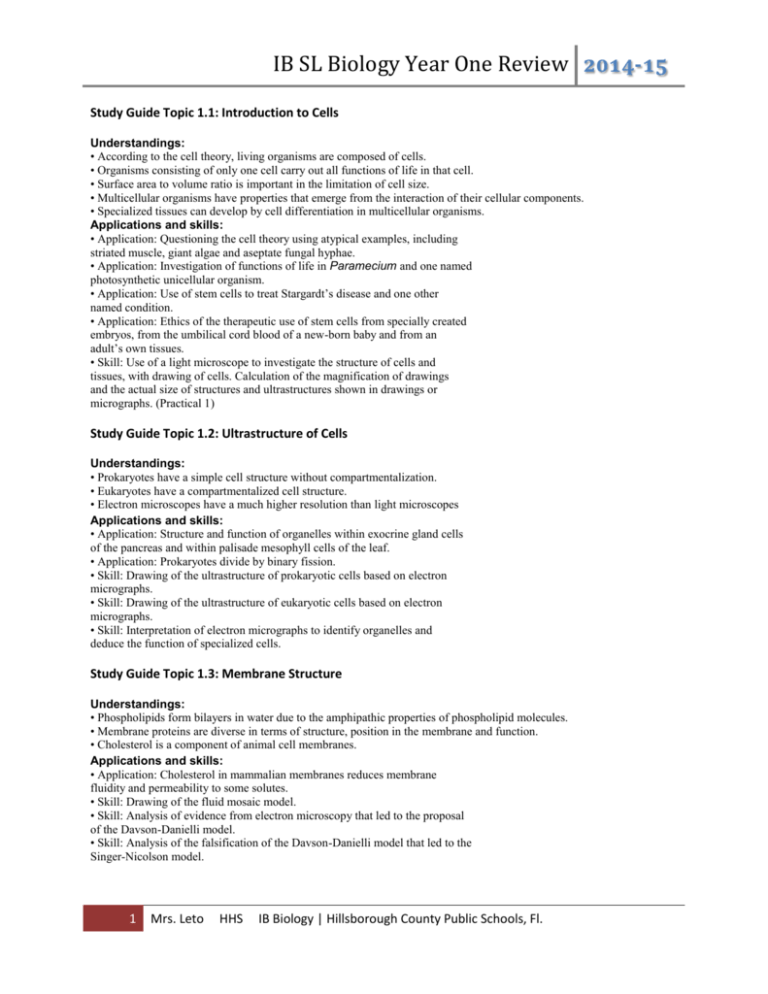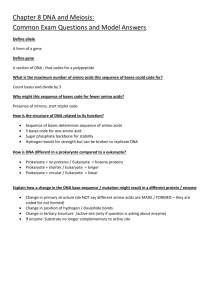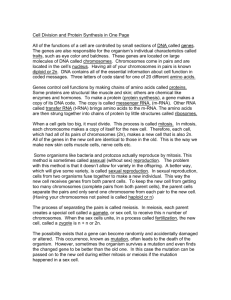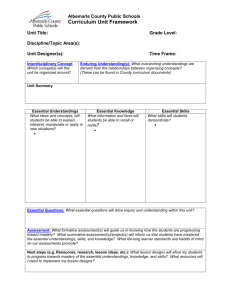IB SL Biology Year One Review
advertisement

IB SL Biology Year One Review 2014-15 Study Guide Topic 1.1: Introduction to Cells Understandings: • According to the cell theory, living organisms are composed of cells. • Organisms consisting of only one cell carry out all functions of life in that cell. • Surface area to volume ratio is important in the limitation of cell size. • Multicellular organisms have properties that emerge from the interaction of their cellular components. • Specialized tissues can develop by cell differentiation in multicellular organisms. Applications and skills: • Application: Questioning the cell theory using atypical examples, including striated muscle, giant algae and aseptate fungal hyphae. • Application: Investigation of functions of life in Paramecium and one named photosynthetic unicellular organism. • Application: Use of stem cells to treat Stargardt’s disease and one other named condition. • Application: Ethics of the therapeutic use of stem cells from specially created embryos, from the umbilical cord blood of a new-born baby and from an adult’s own tissues. • Skill: Use of a light microscope to investigate the structure of cells and tissues, with drawing of cells. Calculation of the magnification of drawings and the actual size of structures and ultrastructures shown in drawings or micrographs. (Practical 1) Study Guide Topic 1.2: Ultrastructure of Cells Understandings: • Prokaryotes have a simple cell structure without compartmentalization. • Eukaryotes have a compartmentalized cell structure. • Electron microscopes have a much higher resolution than light microscopes Applications and skills: • Application: Structure and function of organelles within exocrine gland cells of the pancreas and within palisade mesophyll cells of the leaf. • Application: Prokaryotes divide by binary fission. • Skill: Drawing of the ultrastructure of prokaryotic cells based on electron micrographs. • Skill: Drawing of the ultrastructure of eukaryotic cells based on electron micrographs. • Skill: Interpretation of electron micrographs to identify organelles and deduce the function of specialized cells. Study Guide Topic 1.3: Membrane Structure Understandings: • Phospholipids form bilayers in water due to the amphipathic properties of phospholipid molecules. • Membrane proteins are diverse in terms of structure, position in the membrane and function. • Cholesterol is a component of animal cell membranes. Applications and skills: • Application: Cholesterol in mammalian membranes reduces membrane fluidity and permeability to some solutes. • Skill: Drawing of the fluid mosaic model. • Skill: Analysis of evidence from electron microscopy that led to the proposal of the Davson-Danielli model. • Skill: Analysis of the falsification of the Davson-Danielli model that led to the Singer-Nicolson model. 1 Mrs. Leto HHS IB Biology | Hillsborough County Public Schools, Fl. IB SL Biology Year One Review 2014-15 Study Guide Topic 1.4: Membrane Transport Understandings: • Particles move across membranes by simple diffusion, facilitated diffusion, osmosis and active transport. • The fluidity of membranes allows materials to be taken into cells by endocytosis or released by exocytosis. Vesicles move materials within cells. Applications and skills: • Application: Structure and function of sodium–potassium pumps for active transport and potassium channels for facilitated diffusion in axons. • Application: Tissues or organs to be used in medical procedures must be bathed in a solution with the same osmolarity as the cytoplasm to prevent osmosis. • Skill: Estimation of osmolarity in tissues by bathing samples in hypotonic and hypertonic solutions. (Practical 2) Study Guide Topic 1.5: The Origin of Cells Understandings: • Cells can only be formed by division of pre-existing cells. • The first cells must have arisen from non-living material. • The origin of eukaryotic cells can be explained by the endosymbiotic theory. Applications and skills: • Application: Evidence from Pasteur’s experiments that spontaneous generation of cells and organisms does not now occur on Earth. Study Guide Topic 1.6: Cell Division Understandings: • Mitosis is division of the nucleus into two genetically identical daughter nuclei. • Chromosomes condense by supercoiling during mitosis. • Cytokinesis occurs after mitosis and is different in plant and animal cells. • Interphase is a very active phase of the cell cycle with many processes occurring in the nucleus and cytoplasm. • Cyclins are involved in the control of the cell cycle. • Mutagens, oncogenes and metastasis are involved in the development of primary and secondary tumours. Applications and skills: • Skill: Identification of phases of mitosis in cells viewed with a microscope or in a micrograph. • Skill: Determination of a mitotic index from a micrograph. 2 Mrs. Leto HHS IB Biology | Hillsborough County Public Schools, Fl. IB SL Biology Year One Review 2014-15 Study Guide Topic 2.1: Molecules to Metabolism Understandings: • Molecular biology explains living processes in terms of the chemical substances involved. • Carbon atoms can form four covalent bonds allowing a diversity of stable compounds to exist. • Life is based on carbon compounds including carbohydrates, lipids, proteins and nucleic acids. • Metabolism is the web of all the enzyme-catalysed reactions in a cell or organism. • Anabolism is the synthesis of complex molecules from simpler molecules including the formation of macromolecules from monomers by condensation reactions. • Catabolism is the breakdown of complex molecules into simpler molecules including the hydrolysis of macromolecules into monomers. Applications and skills: • Application: Urea as an example of a compound that is produced by living organisms but can also be artificially synthesized. • Skill: Drawing molecular diagrams of glucose, ribose, a saturated fatty acid and a generalized amino acid. • Skill: Identification of biochemicals such as sugars, lipids or amino acids from molecular diagrams. Study Guide Topic 2.2: Water Understandings: • Water molecules are polar and hydrogen bonds form between them. • Hydrogen bonding and dipolarity explain the cohesive, adhesive, thermal and solvent properties of water. • Substances can be hydrophilic or hydrophobic. Applications and skills: • Application: Comparison of the thermal properties of water with those of methane. • Application: Use of water as a coolant in sweat. • Application: Modes of transport of glucose, amino acids, cholesterol, fats, oxygen and sodium chloride in blood in relation to their solubility in water. Study Guide Topic 2.3: Carbohydrates and Lipids Understandings: • Monosaccharide monomers are linked together by condensation reactions to form disaccharides and polysaccharide polymers. • Fatty acids can be saturated, monounsaturated or polyunsaturated. • Unsaturated fatty acids can be cis or trans isomers. • Triglycerides are formed by condensation from three fatty acids and one glycerol Applications and skills: • Application: Structure and function of cellulose and starch in plants and glycogen in humans. • Application: Scientific evidence for health risks of trans fats and saturated fatty acids. • Application: Lipids are more suitable for long-term energy storage in humans than carbohydrates 3 Mrs. Leto HHS IB Biology | Hillsborough County Public Schools, Fl. IB SL Biology Year One Review 2014-15 Study Guide Topic 2.4: Proteins Understandings: • Amino acids are linked together by condensation to form polypeptides. • There are 20 different amino acids in polypeptides synthesized on ribosomes. • Amino acids can be linked together in any sequence giving a huge range of possible polypeptides. • The amino acid sequence of polypeptides is coded for by genes. • A protein may consist of a single polypeptide or more than one polypeptide linked together. • The amino acid sequence determines the three-dimensional conformation of a protein. • Living organisms synthesize many different proteins with a wide range of functions. • Every individual has a unique proteome. Applications and skills: • Application: Rubisco, insulin, immunoglobulins, rhodopsin, collagen and spider silk as examples of the range of protein functions. • Application: Denaturation of proteins by heat or by deviation of pH from the optimum. • Skill: Drawing molecular diagrams to show the formation of a peptide bond. Study Guide Topic 2.5: Enzymes Understandings: • Enzymes have an active site to which specific substrates bind. • Enzyme catalysis involves molecular motion and the collision of substrates with the active site. • Temperature, pH and substrate concentration affect the rate of activity of enzymes. • Enzymes can be denatured. • Immobilized enzymes are widely used in industry. Applications and skills: • Application: Methods of production of lactose-free milk and its advantages. • Skill: Design of experiments to test the effect of temperature, pH and substrate concentration on the activity of enzymes. • Skill: Experimental investigation of a factor affecting enzyme activity. Study Guide Topic 2.6: Structure of DNA and RNA Understandings: • The nucleic acids DNA and RNA are polymers of nucleotides. • DNA differs from RNA in the number of strands present, the base composition and the type of pentose. • DNA is a double helix made of two antiparallel strands of nucleotides linked by hydrogen bonding between complementary base pairs. Applications and skills: • Application: Crick and Watson’s elucidation of the structure of DNA using model making. • Skill: Drawing simple diagrams of the structure of single nucleotides of DNA and RNA, using circles, pentagons and rectangles to represent phosphates, pentoses and bases. Study Guide Topic 2.7: Replication, Transcription and Translation Understandings: • The replication of DNA is semi-conservative and depends on complementary base pairing. • Helicase unwinds the double helix and separates the two strands by breaking hydrogen bonds. • DNA polymerase links nucleotides together to form a new strand, using the pre-existing strand as a template. • Transcription is the synthesis of mRNA copied from the DNA base sequences by RNA polymerase. • Translation is the synthesis of polypeptides on ribosomes. • The amino acid sequence of polypeptides is determined by mRNA according to the genetic code. • Codons of three bases on mRNA correspond to one amino acid in a polypeptide. 4 Mrs. Leto HHS IB Biology | Hillsborough County Public Schools, Fl. IB SL Biology Year One Review 2014-15 • Translation depends on complementary base pairing between codons on mRNA and anticodons on tRNA. Applications and skills: Skill: Analysis of Meselson and Stahl’s results to obtain support for the theory of semi-conservative replication of DNA. • Skill: Use a table of mRNA codons and their corresponding amino acids to deduce the sequence of amino acids coded by a short mRNA strand of known base sequence. • Skill: Deducing the DNA base sequence for the mRNA strand. Study Guide Topic 2.9: Photosynthesis Understandings: • Photosynthesis is the production of carbon compounds in cells using light energy. • Visible light has a range of wavelengths with violet the shortest wavelength and red the longest. • Chlorophyll absorbs red and blue light most effectively and reflects green light more than other colours. • Oxygen is produced in photosynthesis from the photolysis of water. • Energy is needed to produce carbohydrates and other carbon compounds from carbon dioxide. • Temperature, light intensity and carbon dioxide concentration are possible limiting factors on the rate of photosynthesis. Applications and skills: • Application: Changes to the Earth’s atmosphere, oceans and rock deposition due to photosynthesis. • Skill: Drawing an absorption spectrum for chlorophyll and an action spectrum for photosynthesis. • Skill: Design of experiments to investigate the effect of limiting factors on photosynthesis. Study Guide Topic 3.1: Genes Understandings: • A gene is a heritable factor that consists of a length of DNA and influences a specific characteristic. • A gene occupies a specific position on a chromosome. • The various specific forms of a gene are alleles. • Alleles differ from each other by one or only a few bases. • New alleles are formed by mutation. • The genome is the whole of the genetic information of an organism. • The entire base sequence of human genes was sequenced in the Human Genome Project. Study Guide Topic 3.2: Chromosomes Understandings: • Prokaryotes have one chromosome consisting of a circular DNA molecule. • Some prokaryotes also have plasmids but eukaryotes do not. • Eukaryote chromosomes are linear DNA molecules associated with histone proteins. • In a eukaryote species there are different chromosomes that carry different genes. • Homologous chromosomes carry the same sequence of genes but not necessarily the same alleles of those genes. • Diploid nuclei have pairs of homologous chromosomes. • Haploid nuclei have one chromosome of each pair. • The number of chromosomes is a characteristic feature of members of a species. • A karyogram shows the chromosomes of an organism in homologous pairs of decreasing length. • Sex is determined by sex chromosomes and autosomes are chromosomes that do not determine sex. Applications and skills: Application: Use of karyograms to deduce sex and diagnose Down syndrome in humans. 5 Mrs. Leto HHS IB Biology | Hillsborough County Public Schools, Fl. IB SL Biology Year One Review 2014-15 Study Guide Topic 3.3: Meiosis Understandings: • One diploid nucleus divides by meiosis to produce four haploid nuclei. • The halving of the chromosome number allows a sexual life cycle with fusion of gametes. • DNA is replicated before meiosis so that all chromosomes consist of two sister chromatids. • The early stages of meiosis involve pairing of homologous chromosomes and crossing over followed by condensation. • Orientation of pairs of homologous chromosomes prior to separation is random. • Separation of pairs of homologous chromosomes in the first division of meiosis halves the chromosome number. • Crossing over and random orientation promotes genetic variation. • Fusion of gametes from different parents promotes genetic variation. Applications and skills: • Application: Non-disjunction can cause Down syndrome and other chromosome abnormalities. • Skill: Drawing diagrams to show the stages of meiosis resulting in the formation of four haploid cells. Study Guide Topic 3.4: Inheritance Understandings: • Mendel discovered the principles of inheritance with experiments in which large numbers of pea plants were crossed. • Gametes are haploid so contain only one allele of each gene. • The two alleles of each gene separate into different haploid daughter nuclei during meiosis. • Fusion of gametes results in diploid zygotes with two alleles of each gene that may be the same allele or different alleles. • Dominant alleles mask the effects of recessive alleles but co-dominant alleles have joint effects. • Many genetic diseases in humans are due to recessive alleles of autosomal genes, although some genetic diseases are due to dominant or co-dominant alleles. • Some genetic diseases are sex-linked. The pattern of inheritance is different with sex-linked genes due to their location on sex chromosomes. • Many genetic diseases have been identified in humans but most are very rare. • Radiation and mutagenic chemicals increase the mutation rate and can cause genetic diseases and cancer Applications and skills: • Application: Inheritance of ABO blood groups. • Application: Red-green colour blindness and hemophilia as examples of sexlinked inheritance. • Application: Inheritance of cystic fibrosis and Huntington’s disease. • Skill: Construction of Punnett grids for predicting the outcomes of monohybrid genetic crosses. • Skill: Analysis of pedigree charts to deduce the pattern of inheritance of genetic diseases. 6 Mrs. Leto HHS IB Biology | Hillsborough County Public Schools, Fl.







